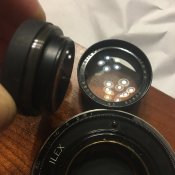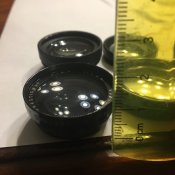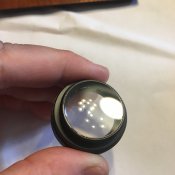I'd like to see better photos, the front and rear cells compared. There's something odd as the rear cell seems disproportionally to large (that's after taking into account being closer to the camera). It could be a mismatched front and rear cells but we'll assume not.
There's no records of a Kodak making a 170mm f6.3 Dialyte, they may have done orhowever it's quite possible it's been bought in and re-badged, At one time Eastman Kodak sold CZJ Tessars as Kodak Anastigmats as Carl Zeiss Jena weren't a known brand in the US. Up until WWI B&L had made Zeiss lenses under licence, as had Ross in the UK etc.
I just looked at a couple of BJP Almanacs 1923 & 1933, in 23 the Kodak 3a camera had a choice of Meniscus, Rapid Rectiliear or f7.7 Kodak Anasigmat (the dialyte), now this is the UK market and Kodak Ltd used British lenses after WWI, so in 1924 the'd dropped the meniscus and adde an f6,8 TTH Kodak Anastigmat alongside the RR and f7.7 Dialyte, by 1933 the top lens was the f6.3 Kodak Anastigmat, and the f7.7 Dialyte was no longer listed.
Kodak's links to outside optical manufacturers is complex, Eastman Kodak were importers & distributors of TT&H (Cooke) lenses in the us for a number of years, and Kodak Ltd were the distributors of Ross and TT&H (Cooke) lenses in Australia and New Zealand. That's just the UK Eastman Kodak of course had links with US manufacturers.
There are references to an f6.3 TT&H Kodak Anastigmatic lens in B&L Compur on an Eastman Kodak No 3 A made around 1916, it's also know that TT & H made Kodak Anastigmat lens without their own name on them. The Cooke Aviar Series III was originally a Triplet but was redesigned as a Dialyte initially being named the Series IIIb Aviariac but quickly dropped to Aviar. At some point in the late 1920s Eastman Kodak stopped distributing TT&H Cooke lenses, and B&J took over.
Now Series III TT&H lenses were sold marked as Kodak Series III in the US (according to VM), and looking in a TT&H advert 1924 there's an Aviar Series IIIb 168mm f6.3 lens, marked FL's are nominal +/- 1 or even 2 at this sort of focal length,.
So maybe we are on the way to the answer

Ian








 Lens hood is a must with dialytes. I have used the Adox CHS 100 II with the 6,3/135 Dogmar with nice results. But now I will be using Fp4 Plus for the first time, and I also have a new to me 4,5/135 Dogmar to try out.
Lens hood is a must with dialytes. I have used the Adox CHS 100 II with the 6,3/135 Dogmar with nice results. But now I will be using Fp4 Plus for the first time, and I also have a new to me 4,5/135 Dogmar to try out. 







